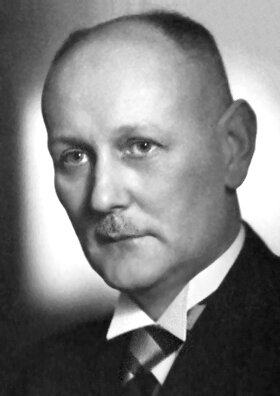To look at a photograph of microscopic life is to see a world of purple and blue. Of swirls and dots. Of course this isn’t the case but actually the result of dyes used to make this invisible world vivid under the lens. Haematoxylin and eosin (H&E) are two such dyes regularly used. Haematoxylin dyes the nuclei of cells (where DNA is stored) blue whilst eosin stains the cytoplasm (the goo which makes up most of the cell) pink. Other structures take on dyes in various amounts to create the remarkable pictures which form the basis of life and disease.
Breast cancer cells viewed under a microscope using an H&E stain. Hematoxylin has stained the cell nuclei blue while eosin has dyed the cytoplasm pink. From Shutterstock.
Such a principle is impressive. But with a bit of lateral thinking it would herald a medical revolution. Decades before Alexander Fleming would find pencillium mould killing cultures of bacteria in his laboratory dyes would form the foundation for the first ever antibiotics.
Paul Ehrlich (1854–1915) was a German biochemist who started experimented with dyes in microscopy. In looking down his microscope and seeing how different cells and structures took up dyes in differing amounts Ehrlich hypothesised that it must be possible to find chemicals which could be taken up bacterial cells but not human cells. If these chemicals were toxic to bacterial cells they would form an anti microbial treatment which would be safe for humans. Such a chemical would be the ‘magic bullet’ doctors were crying out for.
Ehrlich painstakingly tested compounds of arsenic. The 606th compound, Arsphenamine (later called Salvarsen) was shown to destroy Treponema pallidum, the cause of syphillis. Patients with syphillis started treatment with Arsphenamine. Sadly, it proved toxic and killed some of Ehrlich’s patients. But a principle was proven and Ehrlich won the Nobel Prize for Medicine in 1908 for ‘outlining the principles of selective toxicity and for showing preferential eradication of cells by chemicals’.
A stamp printed in Niger shows Nobel Prize in Medicine, Paul Ehrlich, circa 1977. From Shutterstock.
German chemical company, IG Farbenindustrie continued looking at dyes as a potential antibiotic treatment. In 1932 Gerhard Domagk (1895-1964) discovered that a red dye, Prontosil, was toxic against Streptococcus bacteria. What’s more, it was safe in humans. The medical community were sceptical, however. In 1936 President Roosevelt’s son took ill with a sore throat and high fever. After conventional treatments were first exhausted doctors tried Prontosil. It worked and he made a full recovery. Fame followed for Domagk, with the American media extolling the virtues of Prontosil, but not fortune. Whilst Prontosil had a patent over it researchers quickly found that its therapeutic effects only came through it being metabolised in the body into sulphanilamide which didn’t have a patent. Sulphanilamides were free to be made by any drug company who wanted to. Domagk would still be celebrated by the scientific community and, like Ehrlich, was awarded the Nobel Prize, this time in 1939. However, the prize was frowned upon by the Nazis and Domagk was apprehended by the Gestapo when he attempted to travel to receive it. He was finally free to receive it in 1947.
Gerhard Domegk. Creative Commons.
However, by the time Domagk was awarded his Nobel Prize the potential of penicillin was starting to be realised. To Alexander Fleming would come fame. His story of serendipity and not those of Ehlrich and Domagk’s painstaking research would become part of folklore. However, the story of antibiotics does not stop with Fleming. There would need to a crucial intervention from someone with even less recognition than Ehlrich and Domagk. But more of that story later.
Thanks for reading.
- Jamie



